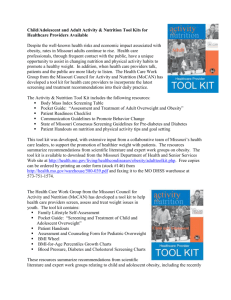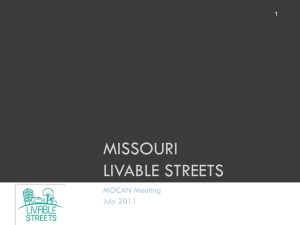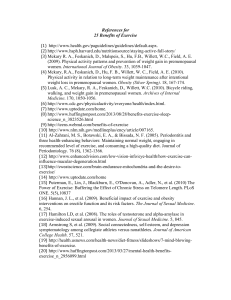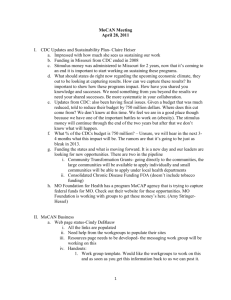MOCAN Strategic Plan 2010 an equal opportunity/ADA institution
advertisement
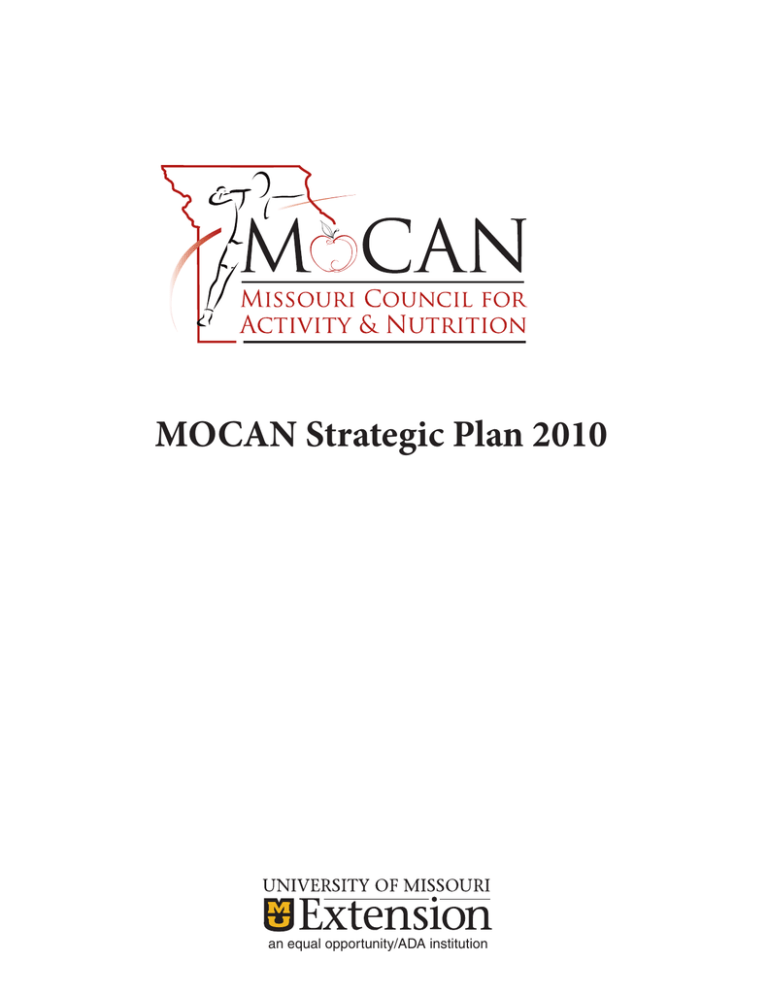
MOCAN Strategic Plan 2010 an equal opportunity/ADA institution MOCAN Strategic Plan 2010 Introduction Many significant strides have been made since the first nutrition and physical activity plan to prevent obesity and other chronic diseases was published in 2005. That first plan was prepared by the Missouri Department of Health and Senior Services with the guidance and thoughtful contributions of the State Physical Activity Plan Work Team and the Missouri Council on the Prevention and Management of Overweight and Obesity. In addition, more than 800 Missourians throughout six (6) locations provided comments during the development process to assure that the plan would make an impact on their nutritional and physical activity behaviors. Thanks to the members of the Missouri Council for Activity and Nutrition (MOCAN) for their work in updating the 2005 Nutrition and Physical Activity Plan to Prevent Obesity and Other Chronic Diseases. The steering committee’s leadership in this process is also greatly appreciated. Because of their leadership, MOCAN also restructured the council to better reflect the new strategic plan and to position the council to better meet the needs of the target population. As a result, two new work groups, Food Systems and Built Environment, were formed and the Families/Communities Work Group was disbanded. Please visit mocan.org. Funding for this project was provided in part by The Missouri Foundation for Health. The Missouri Foundation for Health is a philanthropic organization whose vision is to improve the health of the people in the communities it serves ii MOCAN Strategic Plan 2010 Table of Contents Overview . . . . . . . . . . . . . . . . . . . . . . . . . . . . . . . . . . . . v Goals Goal 1 . . . . . . . . . . . . . . . . . . . . . . . . . . . . . . . . . . . . 1 Goal 2 . . . . . . . . . . . . . . . . . . . . . . . . . . . . . . . . . . . . 5 Goal 3 . . . . . . . . . . . . . . . . . . . . . . . . . . . . . . . . . . . . 6 Goal 4 . . . . . . . . . . . . . . . . . . . . . . . . . . . . . . . . . . . . 7 iii MOCAN Strategic Plan 2010 MOCAN Member Organizations • • • • • • • • • • • • • • • • • • • • • • • • • • • • • • • • • • • • • • • iv Alliance for Healthier Generation American Heart Association Children’s Mercy Family Health Partners Children’s Mercy Hospital and Clinics Department of Elementary and Secondary Education Department of Health and Senior Services Department of Social Services/MO HealthNet Health Care Foundation of Greater Kansas City Healthy Young Partnership Heartland Health Dionne George Kansas City Health Department Kansas City’s Childhood Obesity Collaborative, Weighing In KC Healthy Kids Learfield Communications MO Arthritis and Osteoporosis Program MO Association of Local PH Agencies MO Bicycle & Pedestrian Federation MO Broadcasters Association MO Chapter American Academy Pediatrics MO Diabetes Prevention and Control Program MO Dietetic Association MO Foundation for Health MO Headstart State Collaboration Office MO Nurses Association MO Parks & Recreation Association MO State Medical Association MO State Parks MOSNA, Independence Schools MU Extension Northwest Missouri State University Partnership for Children PedNet Coalition, Inc. Primaris Springfield-Greene County Health Department St. Louis Dairy Council The Prevention Research Center in St. Louis USDA Rural Development Washington University MOCAN Strategic Plan 2010 Overview MOCAN is a coalition of approximately 81 organizations that impact the nutritional intake and physical activity levels of Missouri residents. Thirty-nine of those organizations have signed a formal member form. MOCAN is made up of a steering committee that has representatives from each work group and membersat-large. During 2010, MOCAN revised the 2005 Nutrition and Physical Activity Plan to Prevent Obesity and Other Chronic Diseases. The revised plan guides members in their collaborative efforts to improve the nutrition and physical activity opportunities available to Missouri residents. Consuming more fruits and vegetables, increasing physical activity, breast-feeding infants, reducing screen time and consuming fewer high energy-dense foods have been shown to decrease the risk of obesity. During the plan revision process, the status of major indictors and accomplishments was assessed. The assessment indicated that progress has been made in changing policies and environments in homes, schools, communities, worksites and health care to support healthy eating and physical activity. Ten percent of public and private schools in Missouri now incorporate locally grown food into school meals or snacks. Policy changes in the last few years include: the Missouri WIC Program implementing the new national law providing fruits and vegetables as part of the supplemental food package provided by the program; the Missouri WIC Program allowing only lower fat milk on all food packages unless medically or developmentally indicated; the Governor signing a bill reauthorizing the Joint Committee on Urban Agriculture as passed by the Missouri Legislature; the Missouri Legislature signing a resolution supporting Complete Streets concepts in Missouri. Other resources that were provided to schools, worksites and health care facilities to address child and adult obesity included: • A model of a local wellness policy that schools can use to develop their own, as required by the Child Nutrition Reauthorization Act. • “Eat Smart Guidelines” for schools and child care facilities to use to improve the food environment in their facilities. • Health care provider toolkits for children, adolescents and adults. • Worksite wellness toolkit. v MOCAN Strategic Plan 2010 • • • • • Farm-to-School “how-to” manual. “Seasonal and Simple for Food Service.” Livable Streets advocacy manual. Livable Streets design manual. Training and educational materials for schools, childcare facilities, worksites, farmers, food distributors, local decision makers, transportation engineers and planners, and health care professionals. • Messages to reinforce good nutrition and physical activity behaviors such as “Live Like Your Life Depends On It,” “Eat Smart. Play More.” and “Don’t Sit. Be Fit.” Obesity, physical activity and fruit and vegetable consumption data between 2005 and 2009/2010 were compared to determine the overall impact of MOCAN’s work. Adults In 2005, 26.9 percent of Missouri’s adult population was obese according to the Centers for Disease Control and Prevention (CDC) Behavioral Risk Factor Surveillance System (BRFSS). By 2010 that percentage increased to 31.4 percent, which is a statistically significant increase. Changing the upward track of adult obesity will take a number of years. Studies show that regular physical activity reduces the risk for obesity, diabetes, heart disease and certain kinds of cancer. While Missourian’s levels of physical activity significantly increased from 2005 to 2009 (46.4 to 50.0 percent), 50 percent of Missouri adults are still not participating in moderate or vigorous physical activity as recommended. However, the increase in physical activity is a positive sign that Missouri adults are taking heed of messages being disseminated. vi MOCAN Strategic Plan 2010 According to the CDC BRFSS, fewer Missouri adults consumed at least five fruits and vegetables between 2005 and 2009, 22.6 percent and 19.9 percent respectively. The reduction was not statistically significant. Experts in the field are exploring the reasons for the decrease. The BRFSS has been revised to increase the kinds of fruits and vegetables for which data is collected. Adult Statistics 2005 2009/2010 Obesity 26.9% 31.4% Physical Activity 46.4% 50% Fruit and Vegetable Consumption 22.6% 19.9% Youth There has been no statistically significant change in the obesity, fruit and vegetable consumption and physical activity rates for middle and high school students between 2005 and 2009 (Missouri Department of Health and Senior Services, Youth Tobacco Survey). For all infants in Missouri, the rate of breast-feeding shortly after birth (within a few days of birth, depending upon when the blood sample for metabolic testing was taken) has risen from 66.9 percent in 2005 to 71.2 percent in 2010. Data regarding consumption of high energy-dense foods and screen time are not collected. vii MOCAN Strategic Plan 2010 viii MOCAN Strategic Plan 2010 Goals Overall goal: Decrease obesity among children, youth and adults. Goal 1 Increase opportunities to adopt physical activity and nutritional habits that promote good health. Strategy 1: Schools and Child Care Assist schools and child care facilities with supporting policies, environments and education that promote healthy food choices and physical activity. Actions 1. Promote ongoing training, assistance and resources for child care centers and education agency audiences on evidence-based strategies that promote healthy food choices and physical activity. CDC Recommended Strategies: #1 and 2. Increase availability and affordability of healthier food and beverages in public service venues. #5. Improve availability of mechanisms for purchasing food from farms. #6. Provide incentives for the production, distribution and procurement of foods from local farms. #7. Restrict availability of less healthy foods and beverages in public service venues. #17a. and 18. Enhance infrastructure supporting bicycling and walking. #19. Support locating schools within easy walking distance of residential areas. #22. and 23. Enhance personal and traffic safety in areas where persons are or could be physically active. 2. 3. Enhance professional preparation for teachers, administrators and child care providers to enable them to support healthy nutrition and physical activity. Identify and recognize successful approaches used in school and child care centers that enable students and staff to improve nutrition and physical activity practices. Strategy 2: Worksites Provide support for workplaces to encourage physical activity and healthy food choices. Actions 1. Educate employers and chambers of commerce about the benefits of workplace policies and environments that provide 1 MOCAN Strategic Plan 2010 healthy food options and opportunities for physical activity. 2. Assure ongoing training, resources and assistance to employers in assessing, improving and evaluating policy and environment changes that support healthy food choices and opportunities for physical activity and breast-feeding. CDC Recommended Strategies: #1. and 2. Increase availability and affordability of healthier food and beverages in public service venues. #5. Improve availability of mechanisms for purchasing food from farms. #7. Restrict availability of less healthy foods and beverages in public service venues. #8. Institute smaller portion size options in public service venues. #10. Discourage consumption of sugar-sweetened beverages. #11. Increase support for breast-feeding. #14. Increase opportunities for extracurricular physical activity. #17. and 18. Enhance infrastructure supporting bicycling and walking. #20. Zone for mixed-use development. #22. and 23. Enhance personal and traffic safety in areas where persons are or could be physically active. #24. Participate in community coalitions or partnerships to address obesity. 3. Identify and recognize successful approaches used by employers that enable employees to improve nutrition, physical activity and breast-feeding practices. Strategy 3: Built Environment Assure access to physical activity and healthy eating through the support of environments that provide opportunities for active living and nutritious food choices. Missouri Livable Streets Design Guidelines August 2011 2 Actions 1. Identify and educate key state and community stakeholders about the impact of the built environment on obesity and quality of life, and the benefits of community-based obesity prevention strategies. 2. Empower citizen groups to advocate for policies and environments that support healthy eating and physical activity. 3. Support the development of community coalitions to address healthy eating and physical activity through policy and environmental approaches. 4. Provide ongoing training, resources and assistance to key stakeholders to: a. Assess policies and environments that impact physical activity and healthy eating. MOCAN Strategic Plan 2010 b. Identify evidence-based strategies that address issues identified. c. Evaluate impact of strategies. CDC Recommended Strategies: #3. Improve geographic availability of affordable, healthier food and beverage choices in public venues. #4. Provide incentives to food retailers to locate in and/or offer healthier food and beverage choices in underserved areas. Seasonal and #16. Improve access to outdoor recreational Simple for facilities. #17. and 18. Enhance infrastructure supporting Food Service bicycling and walking. A guide for quantity preparation and service of fresh fruits and vegetables #19. Support locating schools within easy walking distance of residential areas. #20. Improve access to public transportation. #21. Zone for mixed-use development. #22. and 23. Enhance personal and traffic safety in areas where persons are or could be physically active. 5. Identify, recognize and promote successful approaches for improving policies, environments and programs that enable residents to improve nutrition, physical activity and breast-feeding practices. Strategy 4: Food Systems Enhance access to healthy foods through support of approaches that provide increased opportunities for nutritious food selection. Actions 1. Educate consumer groups to create demand and support for healthy products. 2. Educate key stakeholders and other policymakers about the benefits of evidence-based strategies to increase access to healthy foods. CDC Recommended Strategies: #1 and 7. Increase availability of healthier and restrict availability of less healthy food and beverage choices in public service venues. #3. Improve geographic availability of affordable, healthier food and beverage choices in public venues. #4. Provide incentives to food retailers to locate in and/or offer healthier food and beverage choices in underserved areas. #6. Provide incentives for the production, distribution and procurement of foods from local farms. 3. Assure education for food producers, distributors and manufacturers that enable them to meet consumer demand for safe, affordable products. 4. Assist in establishing infrastructure that supports linkages between food 3 MOCAN Strategic Plan 2010 producers, distributors, manufacturers and consumers. CDC Recommended Strategies: #3. Improve geographic availability of affordable, healthier food and beverage choices in public venues. #5. Improve availability of mechanisms for purchasing foods from farms. #6. Provide incentives for the production, distribution and procurement of foods from local farms. 5. Collaborate with the food industry and advertisers to deliver messages that promote healthy food choices. 4 MOCAN Strategic Plan 2010 Goal 2 Increase the effectiveness of MOCAN marketing and messaging that results in improving nutritional habits and increasing physical activity. Strategy MOCAN and its work groups will deliver targeted, proven messages that consistently communicate how to safely and effectively improve nutrition and physical activity practices. Actions 1. Gather and compile examples of existing educational initiatives and messages that have been effectively used to motivate target audiences to improve nutrition and physical activity consistent with the goals and priorities of MOCAN. 2. Prioritize a select number of messages and materials for use by all MOCAN workgroups and initiatives to ensure the consistent use of messages/materials across various settings (schools, child care, work places, health care, community initiatives and advocacy groups) to build “recognition through repetition.” 3. Facilitate development of talking points, fact sheets and other materials as needed to support and meet the more specific messaging needs of various MOCAN work groups and initiatives. 4. Use social media to share success stories of MOCAN members, communities and public. 5. Collaborate with the media to ensure fair and consistent coverage of nutrition, physical activity and obesity issues, including support of policy and environmental changes consistent with MOCAN goals. 5 MOCAN Strategic Plan 2010 Goal 3 Increase support for health care systems to promote physical activity and nutritional habits that prevent and control obesity and chronic disease. Strategy 1: Health care providers and systems Enhance prevention, treatment and management of weight through improved provider knowledge, skills and resources, including changes initiated by health care reform. activity & nutrition M CAN Missouri Council for Activity & Nutrition Child and Adolescent Actions 1. Assist health care providers and systems with establishing consistent procedures for assessing patient Healthcare Provider nutrition and physical activity habits, determining weight status, prevention and treatment strategies and community advocacy. 2. Providing guidance/education to providers on reimbursement for obesity prevention and treatment for adults and children. 3. Work to disseminate information and provide clarification to primary care providers regarding obesity prevention and treatment as we move through healthcare reform. 4. Create and disseminate a template for developing a resource guide for healthcare professionals to offer to their patients and families. Create a tip sheet for health care professionals about farm to institution and livable streets. TOOL KIT Strategy 2: Awards Sponsor an award annually to both a health care professional and pre-professional who displays outstanding advocacy work in the area of prevention or treatment of obesity. Actions 1. Determine criteria to ideally include advocacy related to farm-to-institution or livable streets. 2. Disseminate opportunity. 3. Determine judges. 4. Present award. 6 MOCAN Strategic Plan 2010 Goal 4 Increase state-level public policies that promote physical activity and nutritional habits to prevent obesity and chronic disease. Strategy 1: School policy Strengthen state policies that support opportunities for children and youth to develop healthy nutrition and physical activity practices. Actions 1. Promote effective implementation of state requirements for physical education and adequate recess time. CDC Recommended Strategies #12. Require physical education in schools. #13. Increase the amount of physical activity in physical education programs in schools. #14 . Increase opportunities for extracurricular physical activity. 2. Encourage establishing state policies for schools to decrease access to nutrientpoor, high-calorie vending and a la carte foods. CDC Recommended Strategies #1. and 2. Increase availability of healthier, affordable food and beverage choices in public service venues. #5. Improve availability of mechanisms for purchasing foods from farms. 3. Ensure compliance with currently established policies and national standards that increase physical activity and nutritious foods in schools and child care centers. CDC Recommended Strategies #7. Restrict availability of less healthy foods and beverages in public service venues. #8. Institute smaller portion size options in public service venues. #9. Limit advertisements of less healthy foods and beverages. #10. Discourage consumption of sugar-sweetened beverages. #14. Increase opportunities for extracurricular physical activity. #15. Reduce screen time in public service venues. #16. Improve access to outdoor recreational facilities. Strategy 2: State policy Actions 1. Promote state policies and supports for healthy nutrition and physical activity practices. a. Farm to Institution b. Livable Streets 2. Deliver messages to public officials about the health and economic costs of obesity in Missouri and supports needed to improve nutrition and physical 7 MOCAN Strategic Plan 2010 activity practices. a. Competitive bid process b. General farm practices 3. Expand nutrition education efforts to help consumers use Supplemental Nutrition Assistance Program (SNAP), WIC Program and food bank benefits effectively to support individual and family nutritional needs. 4. Identify and investigate policy strategies, such as feasibility of state tax incentives for communities and employers to increase support for physical activity (e.g., sidewalks, exercise facilities). 5. Indentify existing mechanisms to track weight status and associated risk factors to help provide information impact of policy change. 8
